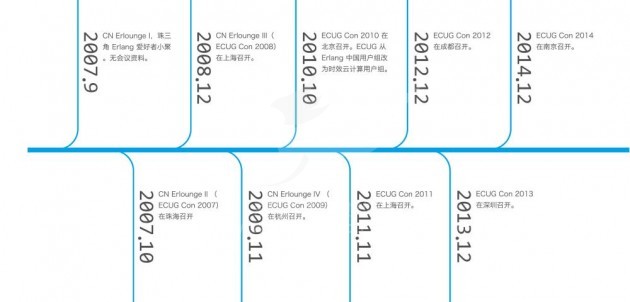
The full name of ECUG is the Effective Cloud User Group, which was launched by Xu Shiwei, CEO of Qiniu Cloud, in 2007. It has gathered a group of colleagues who have high-end perspectives and are still obsessed with the technology itself, focusing on the latest achievements of cloud computing cutting-edge technologies and the best practices of distributed development, operation and maintenance. In the past eight years, the ECUG community has organized a national ECUG Con conference every year, during which many technology gods have participated. They may have rarely appeared in mass technology conferences, but they will talk about their experiences in ECUG Con, and jointly contribute to a semi open high-level technology sharing event.
Development history of ECUG Con

ECUG Con 2015 will be held in Xinjiang Mansion from January 22 to 23, 2016. As the tenth party of great significance, we landed in Beijing, and at the same time, we open our applications to all technical groups for the first time. The purpose of this conference is still to exchange the most cutting-edge technology exploration of cloud computing industry and the most mature practice of server development, operation and maintenance, and to interact and share around the technology evolution and project practice of each lecturer in the past year. The meeting will exchange the following contents:
The company's experience in infrastructure construction, such as distributed programming framework, automated operation and maintenance practices;
Sharing of practical experience in cloud computing, such as OpenStack, Docker, CoreOS, MongoDB, Redis, RabbitMQ, etc;
Sharing of practical experience in the field of big data, such as Hadoop, Spark, etc;
Cloud security related practices, such as penetration testing, DDoS attacks and protection.
Time: January 22-23, 2016
Address: Xinjiang Building, Haidian District, Beijing
Meeting schedule:
Morning of January 22
09:00-09:55 Language of Monday - Xu Shiwei @ Xu Shiwei (CEO of Qiniuyun)
How to implement a language within a week, and what basic knowledge structures are required to implement a language.
Why do we sometimes need a custom language, and what are its actual application scenarios.
10: 00-10:55 Deeply analyze raft protocol and project implementation - Liu Qi @goroutine ( PingCAP CEO )
Analyze the importance of raft protocol in distributed systems, the details of specific papers, and the optimization in the engineering implementation of ETCD and Logcabinet.
11: 00-11:55 Paxos is easy, but building a replicated state machine is not
Due to the confusion of the concept of consistency algorithm and consistent state machine in the engineering field, the distributed consistency algorithm Paxos has always been one of the most difficult algorithms to understand. In fact, it is also one of the most beautiful and concise distributed algorithms. This topic will explain the difference between the consistent algorithm and the consistent state machine, introduce the challenges and solutions encountered in implementing an online consistent system, and focus on the verification of the theoretical and practical correctness of the consistent state machine algorithm, the improvement of performance, and the guarantee of online stability.
In the afternoon of January 22
13: 30-14:25 Yixin's PaaS practice: network management Hong Qiangning @ hongqn (chief architect of Yixin Big Data Innovation Center)
This paper introduces that when using Docker to establish the PaaS system, CreditEase uses Project Calico to implement a pure three-layer container network management scheme. The Docker API hijacking, profile+tag concept, automatic IP allocation, BGP routing management and other functions provided by Project Calico are used to quickly realize a high-performance and manageable distributed container network. And how to use these functions to achieve network security isolation between applications.
14: 30-15:25 Deeply understand Go network programming - Xie Mengjun @ ASTA Xie (founder of GopherChina)
This paper introduces the network programming model of Go. From the implementation of Go, we can see how Go supports millions of connections. From the TCP example, we can see how Go handles network connections, reads and writes, and disconnects.
15: 30-16:25 JD Distributed Database Architecture and Practice - Tian Qi @ Woo Bach (Head of JD Database System R&D)
This paper mainly introduces the analysis and practical experience of the middle tier architecture of JD Unified Database, and analyzes how to achieve transparent data splitting, automatic capacity expansion, seamless online removal, high reliability of data, high availability of services and other functions and architectures.
16: 30-17:25 SofaCloud - Zhang Anzhan @ anzhsoft (heads of SofaCloud and NLPC in Baidu Shangyan Web Search Department)
SofaCloud is a private cloud platform based on Baidu's internal strategy service platform. It aims to serve Baidu's internal services and build a simple and easy-to-use cloud platform. SofaCloud implements the same set of policy services to meet the needs of online, offline, research and other different application scenarios. At present, SofaCloud has run tens of thousands of service instances, with daily computing volume reaching 700 billion, serving Baidu's many heavyweight products. This speech will focus on some problems we encountered in implementing SofaCloud, as well as some experiences in resource scheduling.
Morning of January 23
09:00-09:55 Specific domain extension in an universal language -- ThoughtWorksLead Consultant
In modern languages such as Scala, Java and Haxe, programmers can use modern language features such as macros, dynamic code generation and annotations to reuse the language's native syntax and expand the language's functions. For example, JPA uses annotations to declare the database structure, and Sbt uses macros to automatically infer the dependencies between settings. I call this practice SDE (Specific Domain Extension). Several open source libraries I have written belong to SDE. SDE has the same purpose as DSL (Domain specific Language), which is to solve specific domain problems and create a set of primitives. However, SDE's approach to solving problems is diametrically opposite to DSL's. When we create an SDE, we try to avoid inventing new syntax but reusing the native syntax of the language, and avoid writing external parsers but reusing the native compiler of the language. Therefore, an SDE is easier to integrate into the host language than a DSL, and easier for programmers of the host language to learn.
10: 00-10:55 Elastic Stream -- Wu Xi (Google server engineer)
Deeply explain ElasticStream: a large-scale streaming data processing engine based on the computer room network topology.
11: 00-11:55 Docker's practice in several people - Xiao Deshi @ xds2000 (CTO of several people technology)
The practices of Digital Cloud in technical architecture design, Docker delivery method, microservice application development and full continuous integration, as well as the aspects that need attention in the actual construction process.
Please look forward to more important topics~
Please contact Ding Yiqiong for lecturer application dingyiqiong@qiniu.com
For business cooperation, please contact Zhao Yuting zhaoyuting@qiniu.com














































